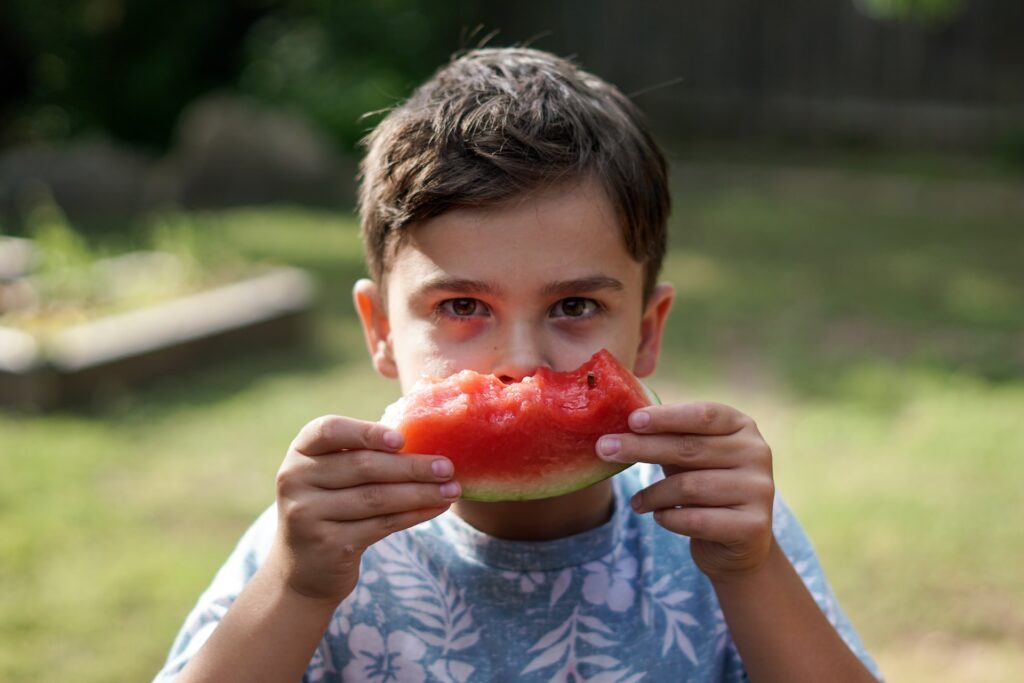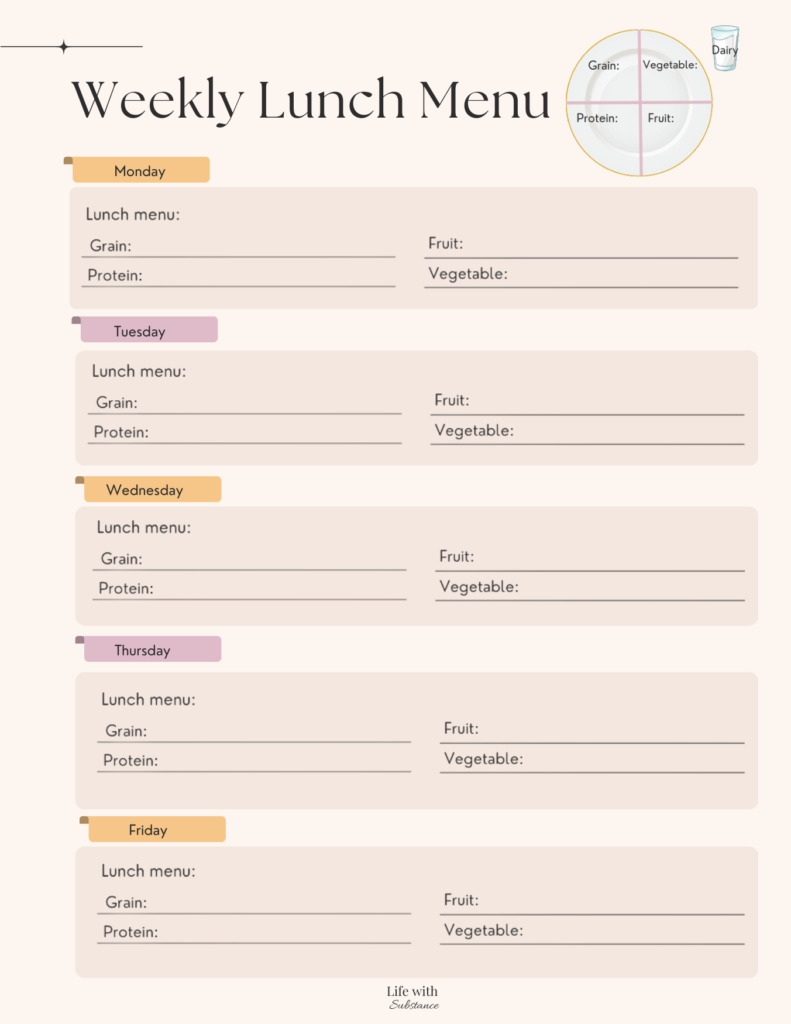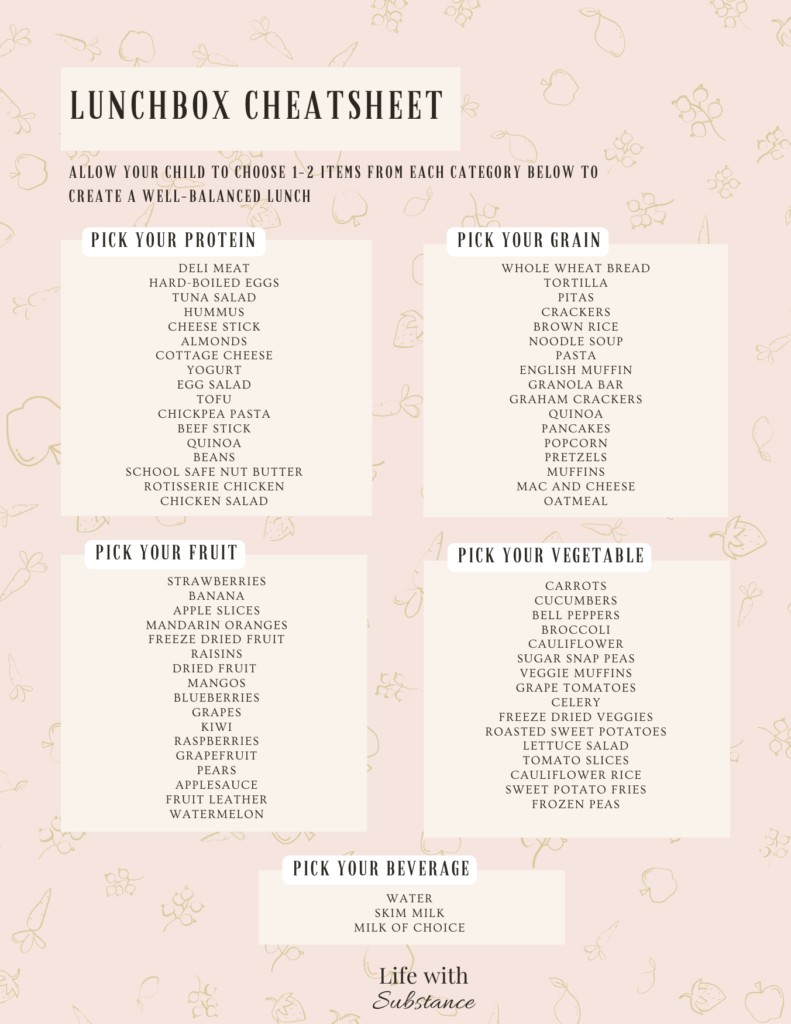This post may contain affiliate links. If you shop from one of our links, we may earn a commission.
Do you feel stuck when it comes to school lunch ideas for kids? Do you find yourself sending the same few items each week because you have picky eaters and don’t know what else to send? Many parents feel the same way and are at a loss when it comes to packing lunches. We want to rest assured that our kids are well-fed so they have enough to hold them over through the afternoon, but that often means we don’t switch up the menu.
Building a Healthy Lunch
Let me start off by saying that every meal won’t be perfect. As moms we often feel pressure to create an “Instagram worthy” packed lunch box that includes all the colors of the rainbow with organic grass-fed protein. Lets be real…we all know our kids won’t appreciate that as much as we might, and that’s okay. Our main goal is to nourish our children, whether it’s chicken nuggets or grilled chicken. Having your kids be involved in picking from each food group can help teach them the foundations of creating balanced meals, while also learning what foods fit into particular categories (apples are fruits, carrots are vegetables, etc). Maybe you have heard the phrase, “Give control to gain control.” Allowing them some ownership of their meal can also help build self-esteem.
Some kids prefer to eat mostly school lunch, others like packing school lunch, and many choose a combination of the two. Whichever option works best for your family is fine. However, there tends to be a lot of stress and frustration around prepping and planning lunches so let’s break this down into simple steps for healthy school lunch ideas.
Step 1: Pick your protein
Many parents are concerned that their children don’t consume adequate amounts of protein, especially if they are a picky eater. But the reality is that protein deficiencies in the United States are actually quite rare. Protein is an essential macronutrient to help your child stay satisfied for longer. Animal proteins can be unappealing for picky eaters, but consuming protein doesn’t mean your child has to eat meat as there are plenty of plant-based proteins as well.
Animal sources of protein contain essential nutrients such as:
Vitamin B12: beneficial for brain and nerve development
Heme iron: a form of iron that is more readily absorbed by the body
Unfortunately, plant-based proteins don’t contain vitamin B12 and heme iron but they do contain:
Fiber: helpful in promoting regular bowel movements
Non-heme iron: this form of iron is not as easily absorbed by the body. Pair these items with vitamin C-rich sources (such as citrus fruits) for better absorption.
Animal proteins for lunch boxes:
Deli meat, cottage cheese, yogurt, slice of cheese or string cheese, beef stick, hard-boiled eggs, cheese quesadillas, cheese sandwiches, leftover chicken or rotisserie chicken

Plant proteins for lunch boxes:
Nut or seed butters, nuts, hummus, tofu, quinoa, beans, lentils or chickpea pasta
Check out this post for more guidance on how much protein your child needs and ways to encourage protein intake in picky eaters.
Step 2: Pick your grain
Grains are a primary source of carbohydrates. Unfortunately, carbs have a bad reputation. But did you know that carbs are actually the main fuel source for your child’s body? Carbohydrates break down into glucose (sugar) to provide adequate energy for your child. Grains also tend to be a fan-favorite food group for most kids. Don’t feel frustrated if your child prefers a grain-heavy diet; that’s totally normal for many kids. Over time they will continue to expand their food choices and include more variety. Grab my picky eating guide if you need help expanding your child’s diet.
Whole grain confusion
People often feel confused by the term “whole grain”. Labels may include words such as “honey wheat”, “multigrain”, “made with whole grains”, or “12 grain”. When trying to determine if the product is truly a high-quality whole-grain product, look for these things:
- Whole grain stamp on the product
- Look for the word “whole”. Words such as “wheat germ”, “wheat flour”, “multi-grain”, “enriched flour” does not mean that item is a whole grain. It should specifically state “whole” in front of any grain ingredient.
- Ingredients are listed in order of dominance on a nutrition label. The first or second ingredient should be a whole grain.
Grain options for lunch boxes:
Whole grain crackers, whole wheat tortillas, whole wheat bread, pasta, pita bread, pretzels, oatmeal, granola bars, English muffins, brown rice, muffins
Step 3: Pick your fruit
Fruits generally tend to be more appealing to kids because of their natural sweetness. I often hear parents say they worry about giving their kids “too much fruit because of all the sugar”. Yes, when fruit gets broken down in our bodies it turns to sugar. But so do grains, some dairy, and starchy vegetables. This is not at all a bad thing because it provides fuel for our bodies along with vitamins, minerals, and fiber. Plus fruit and dairy products are naturally occurring sugar versus added sugar that we find in bars, cereals, etc.

Fruit juice
Parents commonly ask me, “Is fruit juice okay if my child doesn’t like fruit?” The biggest thing to be cautious about is that juice isn’t getting abused. If you serve juice, keep it to a 4oz serving per day of 100% real fruit juice. When juice is consumed in excess kids then fill up on the juice while missing out on all the added benefits of real fruit and other foods. Although 100% fruit juice does count as a serving of fruit, whole fruit is always the best option.
If your child doesn’t care for most fruits “yet”, just be patient and keep providing opportunities for exposure. For example, if your child struggles with strawberries, try putting them in smoothies to help them get used to the taste without having to eat a whole strawberry first. A fan favorite bar in our house is That’s It bars. They are literally just fruit, that’s it! They are just one more way to expose children to certain flavors but in a different form. You can find more tips in my picky eating guide.
Prep fruits for ease
Some fruits require prep before eating. Since lunch time at school is usually pretty short and kids don’t have much time to eat, it would be a good idea to prep your kids’ fruits and vegetables ahead of time by peeling oranges, slicing apples, etc. But fresh fruit doesn’t have to be the only option. Switch it up between individual fruit cups, dried fruit, freeze-dried fruit, and fruit bars.
Fruit options for lunch boxes:
Applesauce pouches, fresh berries, mandarin oranges, fruit bars, freeze-dried strawberries, grapes, apple slices, raisins, peach fruit cups, Craisins
Step 4: Pick your vegetable
Vegetables tend to be the least favorite food group. Unlike fruit, they tend to be a little more bland and can have strong flavors. As parents we really want our kids to like vegetables, which sometimes turns into us bribing or fighting about taking just one bite. The best thing you can do is to not force it. Keep providing opportunities to try them knowing they will come around over time.
Packing vegetables
Packing vegetables in lunch boxes can be a little tricky. Cooked vegetables tend to be less appealing in lunch boxes as they are generally served warm. Cutting vegetables into shapes is a fun way to make them more enticing. Check out these shape cutters to bring some excitement to their vegetables.
Don’t be afraid to allow your child to use dips and sauces to help encourage vegetable intake. This still exposes them to the taste of the vegetable, and over time they may prefer them without dips.

Vegetables for lunch boxes:
Cucumbers with ranch dressing, carrots, bell peppers, celery with peanut butter, broccoli, cauliflower, sugar snap peas, jicama, veggie pouches
Step 5: Pick your beverage
If your child eats the hot lunch at school they have the option of grabbing a carton of milk. Even if your child brings a sack lunch they can pick a milk there, but sometimes it saves time and is easier for little ones to put something in their lunch box. There are several shelf-stable milk options to choose from (Horizon Organic Milk, Ripple Vegan Milk, Silk Almond Milk) that include cow’s milk, pea protein milk, or soy milk. If milk feels difficult to pack, then water is always best.
Beverage options for lunch boxes:
Water, fruit-infused water, shelf-stable milk
Step 6: Pick your dessert
Yes, you read that right. Allowing your child to include a child-size serving of dessert with their lunch is beneficial for a few reasons.
Having dessert with the meal helps to neutralize the food
When dessert is served after the meal we teach kids that dessert is seen as a reward for eating their food. By doing this we are putting sweets on a pedestal and making them a highly desired item. When we follow this method it makes our kids crave and seek those foods more, but they may also feel guilt or shame for eating a “bad” food. Kids who are forced to eat foods in order to get dessert often grow to have a dislike for foods, such as vegetables, because of their negative association with them.
Serving dessert after a meal also teaches your child to eat beyond their fullness cues
Because kids strongly desire to have these coveted foods, they will generally eat what is forced to get the dessert. Often times this means they are eating when they are no longer hungry.
Including dessert with the meal can actually be very helpful for picky eaters
Offering a dessert with the meal helps them know they have something they enjoy eating available to them. This can encourage a willingness to try other foods as well. Picky eaters will sometimes only take a few bites of their meal in order to get dessert, but they leave without feeling fully satisfied because they are so excited about dessert.
I’m not saying dessert should be served with every single meal, or necessarily every single day. However, allowing it to be a part of their meal every once in a while still encourages healthy eating behaviors. Read more about the benefits of desserts here.
Packing Lunches with Kids
Breaking down the meals into separate components helps you to create healthy school lunch ideas. A fun way to get kids involved in planning lunches is to print off this meal plan and fill in the sections with lunch ideas together. This can also be done with breakfast and supper if desired. Inviting your children into the process of meal planning is a great way to encourage excitement and ownership of their meals.
Meal examples:
Sample 1 –
Peanut butter sandwich
Protein: Peanut butter
Grain: bread
Fruit: banana
Vegetable: carrots
Dairy: Yogurt
Optional dessert
Sample 2 –
Cheese roll-up
Protein: cheddar cheese
Grain: whole wheat tortilla
Fruit: grapes
Vegetable: cucumbers with ranch
Dairy: shelf-stable milk
Tips for a successful lunch:
Include safe foods
Safe foods are items that you know your child enjoys and will happily eat. These types of foods are particularly helpful if you have a picky eater on your hands. This allows them to feel assured that they have enough to fill their tummy even if there are newer or less desirable items being served. For example, pair a leftover pasta dish that your child wasn’t as comfortable trying with items they do like. This may include fruit, yogurt, crackers, string cheese, etc.
Prep foods to eat
Unfortunately, time is limited during lunch. Most kids only have about 20 minutes or less to eat their food by the time they sit down. If you are packing your child’s lunch, help them by pre-tearing or opening packages of items in their lunch box to help save them time.
Be aware of potential choking hazards
This is more geared towards kids 4 years and younger. Potential choking hazards include whole grapes, blueberries, nuts, peanut butter, seeds, hot dogs, or large pieces of raw fruits and vegetables. Cut foods, such as whole fruit or vegetables, into smaller bite-size pieces for safety and so they can readily eat.
Assemble lunches the night before
If your mornings are anything like mine, they oftentimes feel busy and frantic. So packing lunches and snacks the night before helps us alleviate a lot of stress. Packing lunches ahead of time also allows more time for the kids to get involved in picking out their lunch and even prep their food. Ask your child to help with simple tasks like making a sandwich or putting fruit in containers. Taking ownership of their meal can spark an interest in eating more of the options available.
Provide a small serving of less desirable foods
Keep less desirable items or foods your child doesn’t like “yet” to a very small serving. Kids can easily feel overwhelmed if they are served a portion size that is too large, particularly with foods they don’t enjoy quite yet. To prevent food waste and meal time anxiety, serve only a bite or two of that particular item. Over time they may start to enjoy that food item more and you can gradually increase the serving size.
Create lunch bins
Creating bins in your fridge or pantry for each food category is a really great option to help your children assemble their lunches. Encourage them to pick one item from each bin. For example, in the protein bin place items such as yogurt, string cheese, lunch meat, hard-boiled eggs, and cottage cheese for them to pick for their protein category.
Don’t forget condiments!
Condiments can make an item more appealing to encourage intake. I know for my kids a side of ketchup makes everything better. Other condiments such as barbecue sauce, ranch dressing, sour cream, ketchup, or hummus can be a great way to make lunches more appealing.
Freeze certain foods to use as an ice pack
Place yogurt tubes, grapes, or other items that freeze well in the freezer to act as an ice pack and stay colder for longer.
Build your own “Lunchable”
Create your own “Lunchable” with build-their- own English muffin pizzas, ham and cheese crackers, or other fun lunch combinations. Breakfast for lunch is always a favorite. Kids always love creating and feeling like they made their own meals.
Grab my school lunch cheat sheet for free here for a larger selection of school lunch ideas
In Summary
Coming up with school lunch ideas that your kids will enjoy can be tricky, but getting your child involved in the planning and preparation process can help encourage excitement around lunchtime. Don’t stress if they aren’t perfectly balanced every day or look Instagram-ready. What’s more important is helping your child learn how to have a joyful love of food.



